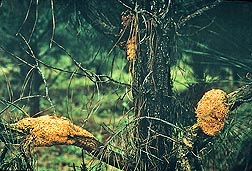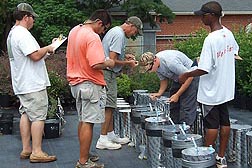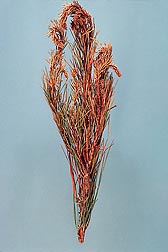Addressing Climate Change in Forests, Container Crops
|
|
Climate change poses a two-pronged threat to the timber industry in the southeastern United States. Droughts are expected to increase, and tree diseases could become more severe and more common.
Brett Runion and his Agricultural Research Service colleagues Allen Torbert and Steve Prior at the National Soil Dynamics Laboratory in Auburn, Alabama, are helping to address that threat by probing the effects of climate change on diseases that damage trees harvested for paper and wood products. They are also working with university partners to provide guidance to nursery container-crop producers on ways to reduce their climate-change footprint.
Disease, Drought, and Elevated CO2
Levels of carbon dioxide (CO2) in the atmosphere are expected to continue increasing. ARS scientists are studying the effects of rising CO2 levels on various plants and soils.
Loblolly pines are a major resource for the timber industry in the Southeast and are susceptible to a number of fungal diseases. A key question is whether rising CO2 levels will increase the incidence and severity of disease.
Runion and his colleagues used open-top field chambers to expose loblolly pine and red oak seedlings to twice the normal levels of CO2 for 6 weeks, then inoculated them with two common fungal pathogens that cause two diseases, pitch canker and fusiform rust. The researchers then placed the seedlings back in the chambers to grow for 7 months.
The diseases were selected because they cause considerable damage to loblolly pine, but the pathogens need different conditions to survive. Fusiform rust needs living tissue, while the fungus that causes pitch canker depends on a toxin to kill plant tissues so that it can feed on the dead material. Red oak was included in the study because it plays a critical role in the fusiform rust reproductive cycle.
Results showed that both loblolly pine and red oak seedlings grown under elevated CO2 were larger in diameter, height, and weight than seedlings grown under normal CO2 levels. The researchers expected to see fusiform rust increase under elevated CO2 levels because the added biomass would give the pathogen more tissue for infection. They also expected reduced levels of pitch canker because the plants would be healthier and better able to defend themselves against the disease.
Instead, they found that for both diseases, severity was the same under elevated CO2. Disease severity was determined by measuring gall size and length of the lesions formed.
Disease incidence, or the percentage of infected trees, actually decreased. Disease incidence was measured by visually inspecting seedlings for galls or abnormal growths (from fusiform rust) and lesions (from pitch canker).
Trees produce tannins and phenols, which can help fight off infections. Higher CO2 levels may have increased production of these compounds, Runion says.
|
|
The study also showed that higher CO2 levels alter the timing of the fusiform rust reproductive cycle, which may make pine trees less susceptible. Fusiform rust cycles between oak and pine trees via spore dispersal. Pine tissues don’t stay highly susceptible to the spores for long, and the researchers found that elevated CO2 lengthened the interval between inoculation and spore formation in the red oak seedlings.
“It is possible that the delay in spore formation on the oaks could result in lower infection levels in pines, if the delay causes spores to be dispersed after the pine tissues have begun to harden and become less succulent,” Runion says. Results were detailed in the journal New Forests (2010).
Climate change is also expected to increase the number and severity of droughts, which can cause trees to wilt, drop leaves, and perhaps even die. Trees usually recover from a drought once it passes, but a tree infected with pitch canker can exhibit the same symptoms, and it won’t recover when the drought ends.
Foresters assumed such dieback in 800 acres of southeastern loblolly pines several years ago was caused by drought stress, but when the drought ended, they learned that the symptoms were caused by pitch canker exacerbated by the drought, Runion says. In a separate study, he is trying to determine whether droughts increase the severity of pitch canker.
Greenhouse Gas Guidance for Nursery Operators
Christopher Marble and Charles Gilliam, researchers at Auburn University, joined with Runion, Prior, and Torbert to study the effects of container sizes and fertilizer-application methods on greenhouse gas emissions from container crops. There are three methods typically used to apply fertilizer to container crops: incorporating it into the potting media, top dressing the soil, and “dibbling”—where a small hole is poked in the soil, the fertilizer is placed into it, and the crop is planted over the fertilizer.
The researchers used each method to fertilize azaleas grown in containers. They measured levels of CO2, nitrous oxide (N2O), and methane in enclosed chambers weekly throughout the 6-month growing season. Plants were harvested, ground up, and weighed so that the amount of carbon sequestered in them could be approximated.
Results showed negligible differences among the three fertilizer treatments in root and shoot weights, amount of carbon stored in the plants, and methane levels.
Dibbling released the lowest levels of CO2 and N2O. Incorporating fertilizer, which is a common practice in the horticulture industry, caused slightly higher CO2 levels and three times more N2O emissions than the other two treatments.
“It may take a while for producers to change their practices, but our role is to give them the information they need so they can make informed decisions and adapt to possible emission regulations in the future,” Marble says. The results were published in HortScience (2012).
In another study, the researchers compared greenhouse gas emissions from four different sizes of containers used to grow dwarf yaupon holly, a popular woody shrub. They compared 1-year emissions from 3-liter (trade gallon), 1-gallon, 2-gallon, and 3-gallon containers.
Results, detailed in the Journal of Environmental Horticulture (2012), showed that CO2 and N2O emissions generally increased proportionately as container sizes increased, while methane levels were minimal for all container sizes. The researchers noted that container size is just one factor growers need to consider. Smaller containers are placed closer together than large containers, resulting in almost four times more plants per acre, which in turn would release higher levels of CO2 and N2O. The researchers also noted that regardless of container size, production of most nursery crops would likely result in a net carbon gain, even while in production, because of carbon being stored in growing biomass.
The study was the first to compare container-crop emissions based on container size, and Marble says the results have proved useful for estimating state and regional emissions from nursery operations.—By Dennis O'Brien, Agricultural Research Service Information Staff.
This research is part of Climate Change, Soils, and Emissions, an ARS national program (#212) described at www.nps.ars.usda.gov.
To reach scientists mentioned in this article, contact Dennis O’Brien, USDA-ARS Information Staff, 5601 Sunnyside Ave., Beltsville, MD 20705-5129; (301) 504-1624.
"Addressing Climate Change in Forests, Container Crops" was published in the September 2013 issue of Agricultural Research magazine.









